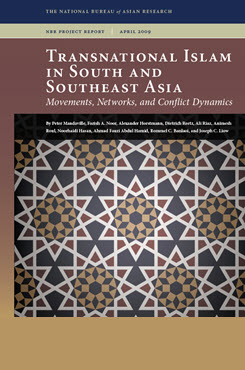From Transnational Islam in South and Southeast Asia: Movements, Networks, and Conflict Dynamics
Transnational Islam in Asia
Background, Typology, and Conceptual Overview
This paper provides an overview of the history of transnational Islam in South and Southeast Asia, identifying key vectors of religious transmission and points of continuity between historical and contemporary patterns of cross-regional Islamic discourse. The paper proposes that contemporary manifestations of transnational Islam problematize conventional categorizations of movements and political ideologies through frequent cross-fertilization across political and militant tendencies. The paper further suggests that the emerging geography of globalized Islam calls into question the extent to which political manifestations of Islam can be analyzed with exclusive reference to local circumstances or sources of discontent.
EXECUTIVE SUMMARY
This paper provides an overview of the history of transnational Islam in South and Southeast Asia, identifying key vectors of religious transmission and points of continuity between historical and contemporary patterns of cross-regional Islamic discourse. The paper proposes that contemporary manifestations of transnational Islam problematize conventional categorizations of movements and political ideologies through frequent cross-fertilization across political and militant tendencies. The paper further suggests that the emerging geography of globalized Islam calls into question the extent to which political manifestations of Islam can be analyzed with exclusive reference to local circumstances or sources of discontent.
MAIN FINDINGS
Manifestations of contemporary transnational Islam in South and Southeast Asia occur in four primary forms: Sufi brotherhoods, renewalist/pietistic movements, Islamist parties and groups, charitable organizations and da’wa organizations; the primary conduits for the cross-border transmission of Islam today include scholarly exchange and study abroad, labor migration, new media, and ritual obligations (e.g. pilgrimage). Influences from transnational Islam do not involve the subversion or eradication of local religious sensibilities but rather a far more complex dynamic whereby external ideas and beliefs are adapted to and grafted onto existing worldviews and conditions. Transnational Islam is not exclusively about religion but can sometimes represent a vocabulary through which broader global debates about political and socioeconomic disenfranchisement can be engaged. The fluidity of transnational Islam on the ground in specific country contexts is such that the social reality of such movement rarely corresponds exactly to the categories and orientations suggested by conventional analytical typologies (e.g. sharp distinctions between “modernist” and “traditionalist” groups).
POLICY IMPLICATIONS
- The involvement of transnational Islamic groups in a localized conflict is frequently associated with an escalation dynamic that raises the ideological stakes of the dispute through association with “global” Muslim causes and by introducing new resources (ideational and material) into the conflict equation.
- Transnational Islamic groups leverage the political sentiments that accrue from both government responses to Muslim grievances and to broader geopolitical issues (e.g. global war on terror, war on Iraq) to build local constituencies.
- At least one form of transnational Islamic networking—that between political parties and movements operating in the “justice and development” mold—holds the potential to serve as an effective and largely democratic space for the aggregation of Muslim discontent and the pursuit of social justice in the name of Islam.
- The complex geographies of transnational Islam, which involve organizations and diasporas located well beyond the confines of South and Southeast Asia, mean that efforts to exert policy influence on Muslim actors in the region may well involve interventions and actors located in the Middle East, Europe, and North America.


